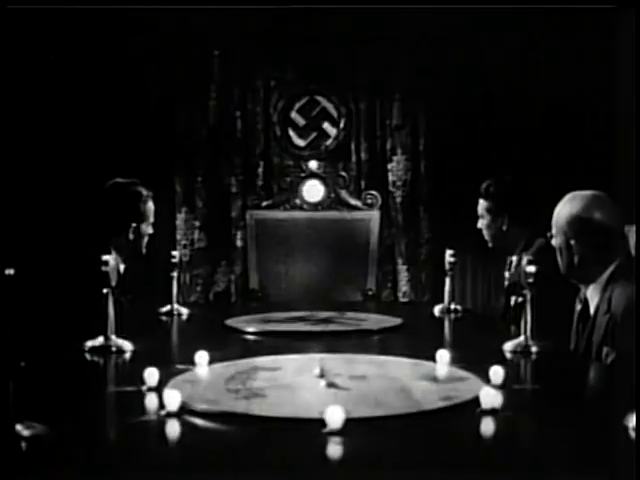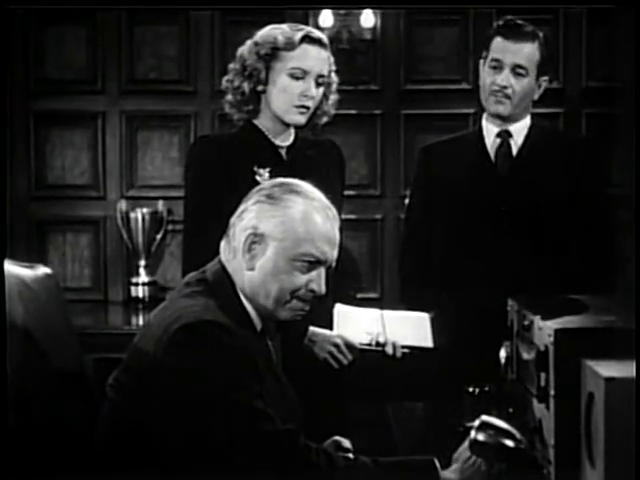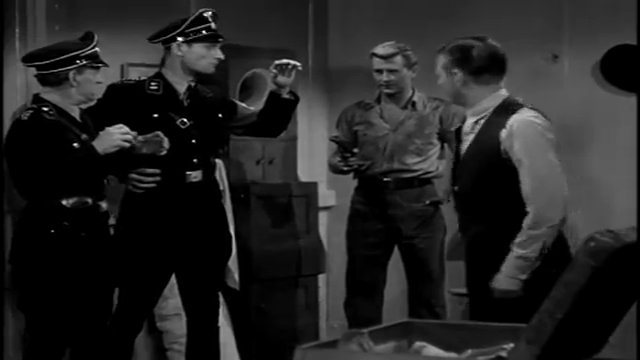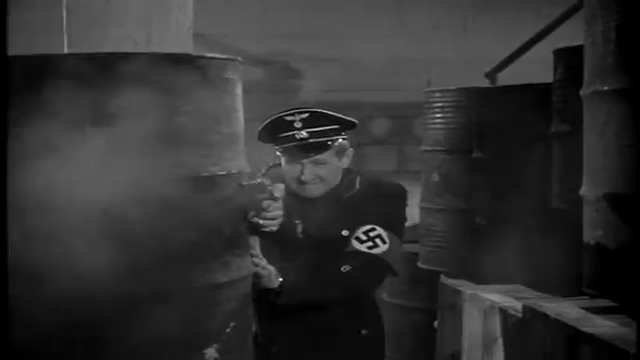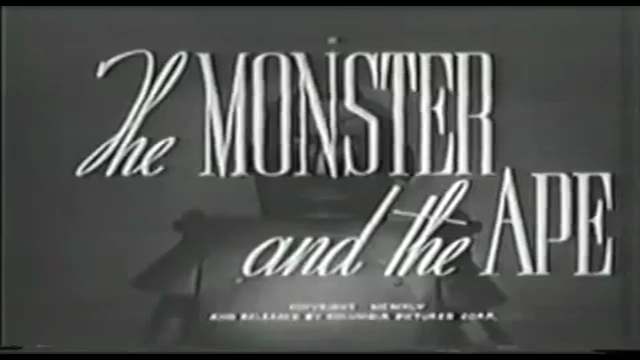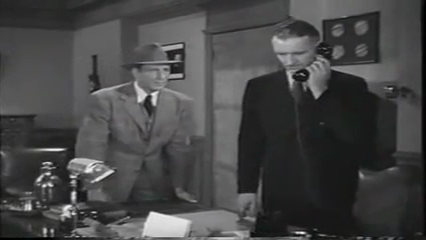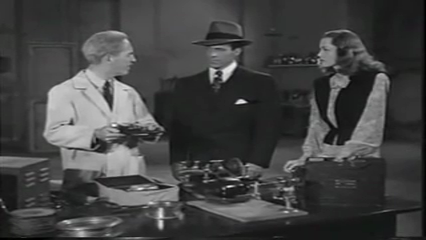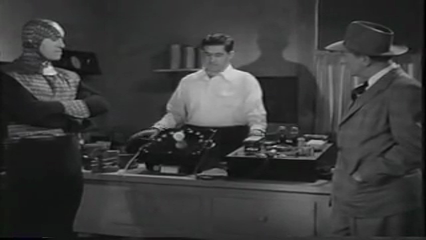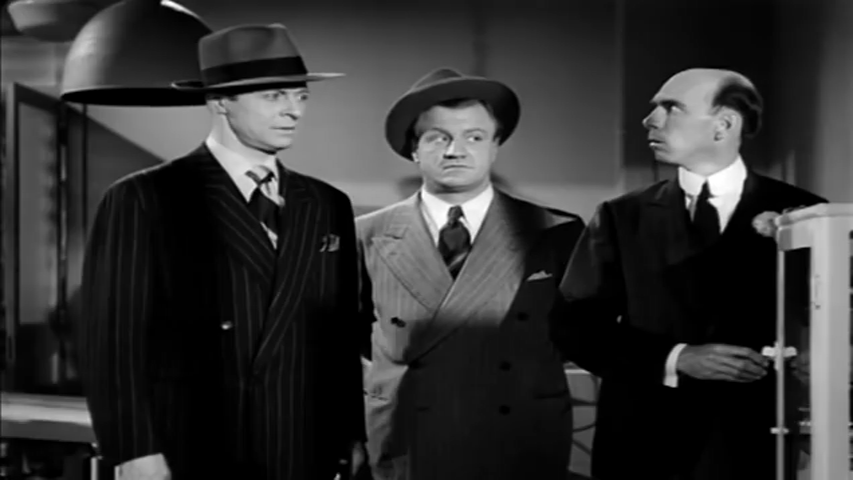-
#469 – The Master Key (1945)
The Master Key (1945)
Film review #469
Directors: Lewis D. Collins, Ray Taylor
SYNOPSIS: A secret Nazi organisation operating in the United States has kidnapped Professor Henderson in order to force him to finish his “auratron” invention that can make gold out of seawater, and use the gold to fund the Nazis operations. Tom Brant, an FBI agent, hunts down the Nazi spy ring with the help of Detective Jack Ryan and his contacts in the police force to find Professor Henderson and bring the Nazis to justice.
THOUGHTS/ANALYSIS: The Master Key is a 1945 serial released by Republic Pictures and comprised of thirteen chapters. The serial centres around a Nazi spy ring operating in the United States, who kidnap Professor Henderson and force him to complete his “auratron” invention, which can turn seawater into gold, which the Nazis will then use to disrupt America’s industrial might. The only thing standing in the way of their evil plans is FBI agent Tom Brant and his companions in the police department. The plot centres around this Nazi spy ring who identify themselves with a key that has the letter “M” and a number engraved on it. They are given their orders by the “Master Key,” who conceals their identity from even the group. That’s all the “Master Key” of the title refers to, and yes, it’s a rather uninteresting premise, given the keys serve no purpose other than to identify the spies, and are used at the start of each chapter to “summon” the master key who explains the plot. The main focus of the plot is Henderson’s invention which apparently turns seawater into gold, an idea which is sounds ridiculous even by the serial format’s standards. The chapters involve the typical plot structure of the heroes trying to rescue the professor and his invention…the amount of serials that enact this same plot is too many to count, and most of them do it better than this one. The plot has very little direction otherwise, and the back-and-forth between the protagonists and antagonists is painfully slow, and explained through long scenes of exposition that slow the pacing down to a crawl. There’s some cliffhangers that incorporate more impressive large crashes or explosions, but they are usually, and obviously, stock footage or models, and the fallout is never really shown, only explained further with the shot of a newspaper front page and even more dialogue.
The characters are the usual bunch you associate with the serial format: there’s the young male leads who get into the fights, the older men who serve as support, and some token women who get the role of journalist or secretary. The villains likewise are uninteresting and have no character or role other than being henchman. The main villain we never see until the very end, instead giving orders through some sort of radio…thing. There’s constantly very little for the viewer to grasp a hold of, and as such, it is difficult to maintain attention on the serial as a whole. There’s some supporting characters including a bunch of younger street-wise teenagers who help out under the watch of Aggie, a similarly street-wise woman. Again, none of the characters really stand out or do anything of merit.
Released in April 1945, The Master Key was released in the very dying days of World War II. As such, it is difficult to see how relevant the whole Nazi spy ring plot was. The wartime serials typically focused on Japan as the primary U.S. enemy, and choosing the Nazis as the villains is perhaps an odd choice at this time. Each chapter opens up with a disclaimer of sorts saying that the serial is fiction that “could never happen,” and states that it takes place in 1938 before the war even started. I assume this was in order to keep the serial in line with the requires of the regulatory bodies, perhaps setting it before the war was necessary to not give the illusion that the Nazis were still a threat to the US in the then dying-days of the war, and that the U.S. was too powerful for something like this to happen anyway. It’s interesting then that they allowed it during wartime: perhaps they needed people to be on their guard, but on the verge of the Nazis being defeated, the tone changed to saying that there was no way that anything like this could ever happen to America. It’s also interesting that the serial clearly identifies the enemies as Nazis and shows their flags in their hideout: again, most serials previously did not mention the Nazis by name or show any of their insignia, instead showing enemies that were working for a “foreign power” which obviously was meant to be the Nazis. Again I assume the requirements of the film regulators changed at the end of the war, and by being able to identify them and place them in the past, it signified that they were a product of history, and no longer a real threat. Also a small note concerning the invention that can apparently turn seawater into gold: it’s so outlandish and nonsensical even by serial standards that it’s very hard to take seriously.
Overall, The Master Key is a poor showing, released at the wrong time. It has very little direction in terms of story or characters, and the long-winded scenes of dialogue and exposition overshadow any action scenes. It exists at a strange point in history where the Nazis were no longer credible or interesting villains, but also before the post-war serials, which turned either to America’s military war heroes battling foreign spies (implied to be the soviet union) or more sci-fi adventures. As such, The Master Key falls between the cracks and fails to find very little relevancy or entertainment value.
-
#446 – Manhunt of Mystery Island (1945)
Manhunt of Mystery Island (1945)
Film review #446
Directors: Spencer Gordon Bennet, Wallace Grissell, Yakima Canutt
SYNOPSIS: When Professor William Forrest, the inventor of a revolutionary new scientific device, is kidnapped, his daughter Claire enlists the help of private detective Lance Reardon to find him. They trace his whereabouts to a private island in the Pacific, co-owned by four individuals. The island is terrorised by Captain Mephisto, a long-dead pirate who is actually one of the owners, who uses a fantastic machine to take the form of his ancestor Mephisto. Lance and Claire have to stop Mephisto from forcing Professor Forrest from finishing his scientific device, which will allow Mephisto to wreak havoc on world industries…
THOUGHTS/ANALYSIS: Manhunt of Mystery Island is a 1945 Republic Pictures serial comprised of fifteen chapters. The serial starts out with Professor William Forrest being kidnapped and forced to finish a new scientific device by the evil Captain Mephisto, who wants to use it to wreak havoc across the world’s industries. Forrest’s daughter Claire enlists the help of private detective Lance Reardon to help find him, leading to them travelling to “Mystery Island” somewhere in the Pacific Ocean. There, they meet the four co-owners of the island, and discover the legends of Captain Mephisto, who used the island as his base some two hundred years ago. When they learn that it is he who has kidnapped the professor, they work on finding his secret base and rescuing the professor. The story has many of the usual set ups that these serials do, and the sheer mix of these tropes, while overbearing at times, at least makes the serial interesting. Each chapter advances the plot in some way and has some sort of consequence for the characters, so it feels at least the story is going somewhere, rather than going around in circles for fifteen chapters, which some of these serials do. There’s chases across land, sea and air, and a decent variety of cliffhangers to keep the excitement going too.
The most unique thing about the serial is the premise of the villain. The identity of Captain Mephisto being one of the four co-owners of mystery island isn’t anything surprising, but his “disguise” is not a disguise at all, but is able to change into the body of Captain Mephisto, who is his ancestor, by using a machine that alters his body. It sounds like something that could have been from the Assassin’s Creed franchise. While this is a unique setup for this serial, it does beg the question why “Mephisto” need Forrest’s device when he has a machine that can literally alter his entire body. Surely he could sell the idea and live perfectly happy for the rest of his life? It certainly seems more revolutionary than the device that he is forcing Professor Forrest to build. If he built it himself, surely he would be smart enough to finish Forrest’s invention himself rather than forcing him to do it? It’s probably best not to think too hard about the plot of these serials. The rest of characters are fairly standard, with the usual male lead and sole female character, Claire, who as usual is the daughter of one of the the characters (women in these serials are usually either related to another character, or work as a secretary or reporter). One thing worth mentioning about her character is that she is a lot more active and involved with the story than other women ins serials, who usually just get kidnapped or hang about at their home in the background. Although there’s some of Claire being kidnapped, she plays a somewhat equal role to Lance, as she accompanies him on many of the dangerous setups, and has to escape many of the same perils. She doesn’t get involved in any of the fist-fighting, but she gets to handle a pistol a fair few times, which again is noteworthy because many of the women in these serials are completely passive and have no effect on events. The minimal number of main cast means that a lot of the action centres around Lance and Claire, giving them much more to do and making them feel more like lively characters.
Being released at the mid-latter end of the serial’s lifespan, it makes use of more advanced special effects and setups than some earlier ones. There’s a lot of re-suing footage, such as Mephisto’s transformation sequence which is the same footage used in every chapter. However, there’s not much stock footage, and the action sequences in boats, cars and airplanes involve the characters, rather than clearly being stock footage from other serials. any of the cliffhangers are fairly creative, although their resolutions are typically anti-climatic, with character just walking away from falling off the side of a cliff without so much as a limp. It’s also pretty funny characters seemingly plunge to their deaths when they are clearly stuffed dummies that flail all over the place. On a side-note, I think this is one of the films George Lucas would have seen as a child, as some of these cliff-hangers are replicated rather faithfully in the Indiana Jones films. In particular, the cliff-hanger to chapter thirteen, which sees Lance and Claire trapped on a suspension bridge and Mephisto cuts the ropes from one side, forcing them to seemingly plunge to their doom, is almost identical to the climax of Indiana Jones and the Temple of Doom. Overall, Manhunt of Mystery Island is a decent serial that, while it’s a mish-mash of many different serial tropes and set-ups, produces a well-flowing story and some unique elements which will keep viewers entertained. Certainly a better than average serial.
-
#426 – Secret Agent X-9 (1945)
Secret Agent X-9 (1945)
Film review #426
Directors: Lewis D. Collins, Ray Taylor
SYNOPSIS: Shadow Island is an island in the Pacific ocean owned by American gangster Lucky Kamber. He has maintained his island’s neutrality during the war, but this has also meant it has become a hotbed for spies from all countries to visit and engage in shady activities. Secret Agent X-9 is sent by America to investigate a Japanese plot concerning something known only as element 722, teaming up with a Chinese agent and Australian spy to take on the Nazi and Japanese forces on the island.
THOUGHTS/ANALYSIS: Secret Agent X-9 is a 1945 serial comprised of thirteen chapters. The film takes place on Shadow Island in the Pacific Ocean, which has retained it’s neutrality on the ongoing World War II thanks to it’s owner Lucky Kamber striking a deal with the Japanese government. However, this neutrality brings in all spies from all warring nations, leading to a hotbed of subterfuge and sabotage. Japanese scientist Hakahima discovers an element known only as “722″ has the capability to replace airplane fuel when mixed with water, thus supplying an infinite fuel source. The head of the Japanese on the island, Nabura, devises a plan to send a criminal to the United States, whose face is altered by plastic surgery, to imitate the professor who discovered element 722 and get the formula from his office, which the professor himself believes to simply be a failed experiment. When Australian spy Lynn Moore learns of this, she informs her superiors, and the Americans send in secret agent X-9 to foil the plot, teaming him up with Chinese agent Au Fong. The setup to this serial is certainly one of the more interesting of the serials I have seen, with this island providing a unique setting for all the warring nations to scheme against each other. The back-and-forth plot of the protagonists sneaking around and attempting to foil the villains schemes is more typical of the serial format. However, there’s a good variety of settings and characters that keeps things interesting, alongside the tense relations between enemies that have to keep in line with the island’s neutrality. There is a lot of dialogue that simply repeats the plot points, but that’s not too uncommon for serials where viewers may not have watched all of the chapters.
The characters are a pretty interesting bunch, and offer a decent amount of variety. Many of the nations involved in the war are represented within these characters, with their own personalities that make them stand out. Secret Agent x-9 himself is played by a young Lloyd Bridges, and is definitely a strong lead, with his shiny blond hair, buff physique and charming personality. Au Fong, the Chinese agent, is played by Keye Luke, who played Kato in the Green Hornet serials, and is a good sidekick. Lynn Moore as the Australian double agent (who has an American accent) who pretends to work for Japanese forces with her radio broadcasts has a fair amount to do, particularly in comparison to other “token females” that are usually found in these serials. There’s also the Nazis that are fairly convincing in their full uniforms, as usually they are only referred to as a “foreign power” and never in the full uniforms. This goes a long way in giving the serial a convincing setting. The main protagonist is Nabura, a Japanese woman, who is played by a white American actress in makeup. This is not unusual at the time, but at least most of the other (male) Japanese characters are played by Asians. Her character comes across as sufficiently scheming and evil, but her portrayal by the actress constantly has her eyes half closed and looking at the floor as if she is reading her lines that are offscreen, which is distracting. Lucky Kamber, the owner of the island, in his portrayal in keeping the island neutral in the war, also has an interesting role as he tries to keep everyone else from tearing each other up. Other minor characters such as Solo, who sits at the same spot playing tiddlywinks for most of the film, and the French hotel owner Papa Pierre, also have their own personality and look which makes them fairly memorable and allow them to bring their own unique flavour to the scenes they are in. It is very rare to find a serial with such a varied cast and to make them interesting enough across the entire serial, but this serial definitely goes a lot further than others.
The setting of Shadow Island provides a decent variety of locations, from the casino, the Nazi ship and the hotel run by Pierre. They are all fairly distinct from one another, so the viewer can keep track of where they are. As mentioned, the characters all have a distinct appearance, from the Japanese soldiers to the Nazi uniforms, their is little doubt about who is who. Probably the weaker elements of the serial is the lack of action sequences, which revolve around the typical fistfights and car chases that you would expect to see. Most of the serial is focused on the intrigue and espionage played out through the characters, so it is important to follow the story. The cliffhangers aren’t too interesting, but there’s one or two novel traps the heroes have to escape from. Overall though, I think Secret Agent X-9 has an interesting and quite unique setup, alongside an array of distinct characters. The heroes are likeable, and the villains despicable, with a few morally grey characters as well to make things interesting. Some elements of the plot are a bit more typical, and the constant re-iteration of plot points can be a little tiresome. There’s less emphasis on action and more on espionage so perhaps some people (particularly younger viewers) may find it a little tiresome, but it distinguishes itself enough to make it a good and fairly unique example of the genre.
-
#402 – The Monster and the Ape (1945)
The Monster and the Ape (1945)
Film review #402
Director: Howard Bretherton
SYNOPSIS: Professor Arnold at the Bainbridge Research Laboratory have completed construction on a revolutionary new robot called the “Metalogen Man” that they believe will be able to accomplish all manual labour. However, after a demonstration to Professor Ernst and three other colleagues, Ernst arranges the deaths of the other three and steals the robot for himself using a trained ape. Ken Morgan, a representative for the company who ordered the robot, teams up with Professor Arnold and his daughter Babs to stop Ernst and recover the robot, before Ernst can find more of the valuable mineral Metalogen and create an army of unstoppable robots…
THOUGHTS/ANALYSIS: The Monster and the Ape is a 1945 movie serial composed of fifteen chapters. The opening chapter sees Professor Arnold give a demonstration at the Bainbridge research Laboratory to Professor Ernst and three other colleagues of “The Metalogen Man”, a human-like robot that will be able to handle all kinds of manual labour. After the demonstration, Professor Ernst arranges the deaths of his colleagues and steals the robot for himself using a giant trained ape named Thor. Ken Morgan, the representative of the company who was going to buy the robot, arrives but finding the robot has been stolen, teams up with Professor Arnold and his daughter Babs to attempt to recover the robot. The story follows Morgan, Arnold and Babs as they try to thwart Ernst’s various schemes to unearth more of the valuable mineral Metalogen to create more robots. The story follows the usual serial format rules, with a lot of back-and-forth between the heroes and villains as the robot and it’s control unit are stolen and re-stolen throughout the fifteen chapters. There are less action scenes and very few chase scenes in vehicles which are typically a staple of the format. The cliffhangers are fairly varied and contain some elaborate traps, but you know how they’re going to end up most of the time.
The “monster” and the “ape” of the title are the robot and Thor. The robot is controlled by a control unit and looks fairly strong and menacing, with its light up eyes and bulky body. Thor is brought out of the zoo by its trainer to carry out the orders of Professor Ernst, and handles jobs such as carrying the robot, which is too heavy for any person to lift. Thor himself is played by Hollywood stuntman Ray Corrigan, who owned the ape-suit and would rent himself and the suit out to movies that required it, and he does a convincing job with it. However, we don’t see nearly enough of the two of them, and most of the action doesn’t involve them. The worst part is we never get to see the two of them fight one another, which is a hugely missed opportunity (and being shown on the posters). Thor dies by being shot in the thirteenth chapter, which is a hugely underwhelming end for the titular character. The rest of the characters follow the usual format, with the lead male doing the action and fight scenes, the sole female character who acts as an assistant or secretary, and the ‘good’ scientist who helps them. There’s also Flash, who plays a comic relief character (I’m not sure what his role in the laboratory actually is), and is played by a non-white actor, which is very rare in 1945. He is played as having a low intelligence and being a coward, which results in him being very much a racist caricature, and is quite problematic to say the least. Professor Ernst as the villain has plenty of schemes, and while he has no special powers, inventions, nor is he hidden behind a disguise like many serial villains, he still has quite an aura of menace about him.
Overall, The Monster and the Ape is a typical serial adventure with few stand outs. It has some elaborate cliffhangers and scenarios that replace the well-worn vehicle chases of other serials, but it’s titular “monsters” are vastly under-utilised, and you can’t help feel a little disappointed with the potential of a robot versus an ape, and what we actually get, which is the sparse use of both and the lack of any confrontation between them.
-
#392 – The Purple Monster Strikes (1945)
The Purple Monster Strikes (1945)
Film review #392
Directors: Spencer Benet, Fred Bannon
SYNOPSIS: A rocket ship from the planet Mars makes a landing on Earth, and the astronomer Professor Layton goes to investigate. he finds a man from Mars as the only passenger on the ship and takes him to his observatory, where he learns the man is actually the first part of an invasion force come to conquer the Earth. After killing Layton, he has the ability to possess his dead body and attempt to get his prototype rocket ship design finish so he can use it to return to Mars and lead the invasion. The only person that can stop him is Layton’s assistant Craig Foster, accompanied by Layton’s niece Sheila.
THOUGHTS/ANALYSIS: The Purple Monster Strikes is a 1945 movie serial. The opening chapter sees a rocket ship crashing to Earth and Professor Layton going to the impact site. There he finds a man from Mars who it turns out to be the first of an invasion force sent to conquer the Earth. The Martian kills Layton and through the use of gas from the Martian atmosphere, is able to possess Layton’s dead body whenever he wants, which he does in order to get Layton’s rocket ship prototype finished, which is the final key to the invasion, as the Martian rocket ships are unable to return to Mars. Learning of the plans of the “Purple Monster”, Layton’s assistant Craig Foster and Layton’s niece Sheila must find a way to foil the Purple Monster’s plan to steal the rocket ship plans. The story unfolds in keeping with almost every other film in the serial format, with each chapter presenting a new scheme from the Purple Monster and Craig and Sheila attempting to foil it. The ability of the Purple Monster to possess Professor Layton’s dead body is a little dark, but it keeps it family-friendly by not dwelling on the details too much. The back-and-forth between the Purple Monster and Layton also adds an interesting dynamic between the characters. The cliffhangers at the end of each chapter are quite ambitious too, and full of high speed chases and explosions. You always know that they’ll result in someone escaping death at the last second, but it still puts some effort into pulling it off.
The characters themselves are a pretty dull bunch. The usual archetypes are all here: the main young white cowboy-esque hero, the token woman, the scientist, the mysterious villain and his henchman: there is nothing inspiring about any of them. We sometimes see the Martian emperor being contacted by the Purple Monster, and his assistant shows up near the end, but neither of them really offer anything exciting or interesting. The whole business with the Purple Monster being able to possess Layton really ties in with one of the main tropes of these serials of the enemy spy hiding in plain sight, and who could be anyone, which really ties into the paranoia around enemy spies in the U.S. during wartime. Other than that though, the cast is rather forgettable.
Overall, while The Purple Monster Strikes has some good special effects and fast-paced action scenes, its characters are dull and bland, and fail to stand out in the format. I think it sits comfortably in the middle of these serials: nothing special, but nothing catastrophically bad either. Being directed by two of the most prolific serial directors, Spencer Bennet and Fred Bannon, they certainly knew what they are doing, but they’re obviously doing it to create a stable source of income rather than trying to innovate at this point into the format’s history.
-
#387 – Dick Tracy (1945)
Dick Tracy (1945)
Film review #387
Director: William A. Berke
SYNOPSIS: Police detective Dick Tracy is investigating a series of murders carried out by a man calling himself “Splitface”. With plenty of suspects around, Tracy has his hands full trying to apprehend the killer, protect the mayor, and keep his girlfriend Tess happy…
THOUGHTS/ANALYSIS: Dick Tracy is a 1945 film and the first feature film in the Dick Tracy franchise, after the four serials made between 1937 and 1941. The film starts out with a murder of a teacher, which Tracy learns has been carried out by a man calling himself ‘Splitface,’ thanks to a note left by the killer demanding a ransom payment. As the film progresses, a number of suspects emerge, and Tracy must use all of his detective skills to work out who the murderer is. The film fits very much in the crime-noir genre, with the high contrast lighting and dark plot. It also evokes the original comic book style with its dramatic perspectives. The story is certainly more of a faithful adaptation of the comic book than the serials with Tracy being a police detective rather than a G-man as he was in the serials. More of the characters from the comic also make an appearance, which will probably be welcome to readers of the comic (I assume a fair amount of people would have heard of the comics back when the film was released). With each new suspect that emerges, there’s a new element to the plot to be explored, and the pacing is quite consistent with allowing these plot points to keep things from becoming stale or dull. There are some unresolved elements that don’t really go anywhere though, such as Judith Owens being reluctant to discuss where her Father is. With a runtime of just over sixty minutes, the film is quite short, but I think it accomplishes what it wants to do.
As mentioned, a number of characters from the original comic make an appearance, creating a varied and interesting cast. A lot of them also have exuberant appearances or names (Deathridge for the undertaker, for example), which emphasises the comic style. despite the gritty film-noir story, there’s some light-hearted comedy moments which seem more comic-esque, and it feels like the film is trying to pull off both at once, with mixed results. One thing I think the serials did better is the use of science-fiction elements which added something unique, and I think was more in-line with the comics. This film has much more realism, but not so much that it is able to stand out in the film-noir genre. One bizarre scene involves a scientist gleaming into a crystal ball and seemingly hypnotising Tess, but that seems completely out of place, and it was never explored if he really did have the power to hypnotise someone.
This film marks the first time that Dick Tracy is not played by Ralph Byrd, instead by Morgan Conway. The tow look and act very differently, and if you’ve seen the serial you might not like the change. Whereas Byrd’s performance was widely praised as a smooth, charming, action man, Conway is clearly older and lacks that charm, instead seeming a bit goofy at times (although Conway probably looks closer to the character as depicted in the comics). This seems to be a largely held consensus, and led to Byrd reprising the role of Tracy for the third and fourth feature films, as well as the television show. Overall, Dick Tracy is a decent enough crime film, with a mix of action, mystery and some comedy, with a film-noir feel that makes things a little more dramatic, alongside incorporating some more elements of the comics. There’s a clash in tone between a gritty murder drama and the more silly comical aspects, and some plot points which aren’t fully resolved, but it’s an easy and quick watch that holds most of its elements together well.

